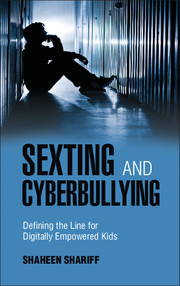Book contents
- Frontmatter
- Dedication
- Contents
- Preface
- Acknowledgments
- Chapter One Confronting Cyberbullying
- Chapter Two Sexism Defines the Lines between Fun and Power
- Chapter Three The Irony of Charging Children with Distribution of Child Pornography
- Chapter Four Keeping Kids Out of Court: Jokes, Defamation, and Duty to Protect
- Chapter Five From Lord of the Flies to Harry Potter: Freedom, Choices, and Guilt
- Appendix A Charting Out Canadian and U.S. Anti-Bullying Legislation (as it Applies or Can be Applied to Cyberbullying Incidents)
- Appendix B Expanded DTL Research Data
- Appendix C Sample Workshop Provided to Undergraduate Students at McGill University
- Appendix D Public Policy, Law, and Digital Media (Sample University-Level Course)
- Index
- References
Chapter Two - Sexism Defines the Lines between Fun and Power
Published online by Cambridge University Press: 18 December 2014
- Frontmatter
- Dedication
- Contents
- Preface
- Acknowledgments
- Chapter One Confronting Cyberbullying
- Chapter Two Sexism Defines the Lines between Fun and Power
- Chapter Three The Irony of Charging Children with Distribution of Child Pornography
- Chapter Four Keeping Kids Out of Court: Jokes, Defamation, and Duty to Protect
- Chapter Five From Lord of the Flies to Harry Potter: Freedom, Choices, and Guilt
- Appendix A Charting Out Canadian and U.S. Anti-Bullying Legislation (as it Applies or Can be Applied to Cyberbullying Incidents)
- Appendix B Expanded DTL Research Data
- Appendix C Sample Workshop Provided to Undergraduate Students at McGill University
- Appendix D Public Policy, Law, and Digital Media (Sample University-Level Course)
- Index
- References
Summary
[I]f it’s like a close friend and he says something offensive then you know he could be joking.
They didn’t think it would be taken seriously!
There’s a point where even if it is a joke, it’s not okay to say some of those things. If it’s hurtful, like if any of my friends said something hurtful like that to me, I probably wouldn’t be okay with that.
(DTL Research respondents)Introduction
In this chapter, I set the context for my discussion of legal responses that seem out of touch with the complexities and nuances of current popular culture and its enormous influence on young people. Although I have defined young people as Digitally Empowered Kids (DE Kids), the influences I discuss in this chapter can “disempower” them, with devastating results. In order to protect, rectify, prevent, and reduce the risks of engagement in online behaviors that can get young people into trouble with peers, school, and the law, it is important that we, as adults, attempt to understand what goes through their minds. Accordingly, this chapter considers a range of social contexts and influences, the DTL Research where we heard from 1,083 participants, and scholarly literature on moral development and moral disengagement. I discuss these considerations in light of well-publicized cases of cyberbullying and sexting, some of which have come to public attention because of the tragic suicides that followed the extreme humiliation and persistent online abuse.
- Type
- Chapter
- Information
- Sexting and CyberbullyingDefining the Line for Digitally Empowered Kids, pp. 36 - 74Publisher: Cambridge University PressPrint publication year: 2014

